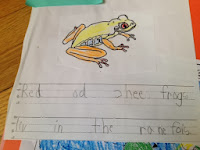After our discussion last week about concepts of print,
especially all of the elements that were discussed in the article “Look:
Examining the Concept of Learning to Look at Print," I began to ponder how
these concepts of print are introduced and reinforced in the 4-year-old
play-based preschool classroom where I assist a few days a week.
In looking at the list of skills involved in concepts of
print included in the article (p. 135), I noted that even in this play-based
environment, we do touch on many of these elements. There are many
daily routines involving print, we have centers devoted to print and writing,
and the students incorporate print into their pretend play.
When students arrive in the morning, their first task is to sign
in. The children are at different levels in their ability to write their names,
but all have progressed to some extent since the beginning of the school year.
For the students just learning to write their names, this arrival time offers
an opportunity to sit down with the student for a minute or two and write a few
letters of their name together. Students are also asked to sign the artwork
they produce during the day, offering them additional opportunities to practice
writing their names.
During morning circle time, student jobs are written out on
the board, and our day in the classroom begins with reading through who is
responsible for each job. A few of these jobs involve print directly. For example, our
“attendance” person puts the pre-printed names of his or her classmates on a
magnetic board. Here is an opportunity to point out the directionality of the
letters (putting the names right side up, horizontally) and some letter
features (Lucy and Lealia both start with the same letter). Another daily job
is “math survey.” One student polls his or her classmates on questions such as
“Do you have a sister?” or “What is your favorite season?” and writes tally
marks for each response, reinforcing that print has a purpose. Another daily routine
involving print is the time for read-alouds, which is obviously a wonderful
opportunity to bring print alive by discussing the characters or setting of the
story, gathering information, making predictions, and making personal connections
to the text.
There are also some centers in the class that are devoted to
print, either on a daily basis or periodically. One permanent feature is the
writing center, stocked with markers, paper, stickers, scissors, etc… where we
can often find children writing letters, lists, invitations, or whatever else
they are interested in. Students often visit the writing center to fetch
materials they need for their pretend play in other centers. The other day some
students set up a stage in the block area and made tickets for their
performance with the materials from the writing center. The book center is a
cozy nook in the corner of the classroom with two comfy chairs and displays of
the books that have recently been read during read-alouds. Students frequently
look or read through these books on their own or ask an adult to re-read them.
It is gratifying that when one child asks me to read a book, several
other children will often join in to listening to the book being read.
One or two of the centers in the class also often feature a
print-based concept. The other day the children put together multiple small
puzzles that formed words with corresponding pictures—each piece contained one
letter of a word and part of the picture (i.e. p-i-g). Journal writing is also
an occasional center activity. The student tells a story (most dictate this to
an adult, who writes it down), based either on a prompt or his or her own idea,
and then illustrates the story he or she has created.
This is by no means a comprehensive list of all of the
print-based activities in the class. My point is that even in a play-based
classroom, there are plenty of opportunities for children to experience print,
and I would assert that since much of it involves their own play, and nearly all
of it involves their own choice, it becomes meaningful for them.
Yet, looking at this list and comparing it to the list in
the article, we do a more thorough job of placing print in context and giving
meaning to print than we do in emphasizing concepts of print involving the
alphabet. Most of the students’ work on the alphabet involves their own name. The
lead teacher is highly committed to maintaining a play-based environment and
letting the children fully experience and appreciate being 4 (rather than
preparing them for kindergarten in an academic way), and I am wondering how to
introduce more of these alphabetic concepts of print into the classroom in a
playful way.
Hovland, M. R., Gapp, S. C., & Theis, B. L. (2011). Look:
examining the concept of learning to look at print. Reading Improvement, 48(3),
128-138. Retrieved from http://search.proquest.com/docview/913286138?accountid=11752










